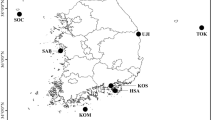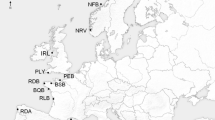Abstract
This study presents the first protein electrophoretic study of population structure within the Georgia Basin Pacific hake Distinct Population Segment, as defined under the U.S. Endangered Species Act. Forty-one allozyme loci (29 polymorphic) were analyzed in samples from three Pacific hake spawning populations on the west coast of North America: (1) Port Susan, Puget Sound, Washington (three temporal samples); (2) south-central Strait of Georgia, British Columbia, Canada (two temporal samples); and (3) offshore of southern California (two temporal samples) (total n = 664). Mean heterozygosity over all loci was 12–13% for all populations. Within-population temporal samples were not significantly different from one another, but statistically significant differences were detected at 15 of the 29 polymorphic loci (p < 0.05) among the three populations. Differences at eight of these loci were highly significant (p < 0.001): ADA *, ALAT *, bGALA *, GPI-A *, sIDHP *, LDH-A *, MPI *, and PEP-B *. The two Georgia Basin populations were significantly different at six loci: bGALA *, sIDHP *, LDH-A *, MPI *, PGK *, and PGM-2 * (p < 0.05). Nei's genetic distance (D) was 0.0006 between Port Susan and Strait of Georgia pooled temporal samples, and 0.005 between these populations and offshore Pacific hake. FST was 0.02 and 0.0046 among all three populations and among the Georgia Basin populations, respectively. Both FST estimates were significantly greater than zero, and the results suggest a high degree of demographic isolation among all three populations.
Similar content being viewed by others
References
Bailey, K.M., R.C. Francis & P.R. Stevens. 1982. The life history and fishery of Pacific whiting, Merluccius productus. Calif. Coop. Ocean. Fish. Invest. Rep. 23: 81–98.
Bailey, K.M. & J. Yen. 1983. Predation by a carnivorous marine copepod, Euchaeta elongata Esterly, on eggs and larvae of the Pacific hake, Merluccius productus. J. Plankton Res. 5: 71–82.
Cavalli-Sforza, L.L. & A.W.F. Edwards. 1967. Phylogenetic analysis: Models and estimation procedures. Evolution 21: 550–570.
Crow, J.F. & K. Aoki. 1984. Group selection for a polygenic behavioral trait: Estimating the degree of population subdivision. Proc. Natl. Acad. Sci. U.S.A. 81: 6073–6077.
Dorn, M.W. 1995. Effects of age composition and oceanographic conditions on the annual migration of Pacific whiting, Merluccius productus. Calif. Coop. Ocean. Fish. Invest. Rep. 36: 97–105.
Ford, M.J. 2002. Applications of selective neutrality tests to molecular ecology. Mol. Ecol. 11: 1245–1262.
Fox, D.A. 1997. Otolith increment analysis and the application toward understanding recruitment variation in Pacific hake (Merluccius productus) within Dabob Bay,WA. Master's Thesis, University of Washington. 73 pp.
Galleguillos, R., L. Troncoso, C. Oyarzun, M. Astorga & M. Penaloza. 2000. Genetic differentiation in Chilean hake Merluccius gayi gayi (Pisces: Merlucciidae). Hydrobiologia 420: 49–54.
Gillespie, J.H. 1991. The Causes of Molecular Evolution, Oxford University Press, New York. 336 pp.
Goñi, R. 1988. Comparison of Pacific hake (Merluccius productus Ayres, 1855) stocks in inshore waters of the Pacific Ocean: Puget Sound and Strait of Georgia. Master's Thesis, University of Washington. 104 pp.
Grant, W.S. & R.W. Leslie. 2001. Inter-ocean dispersal is an important mechanism in the zoogeography of hakes (Pisces: Merluccius spp.). J. Biogeogr. 28: 699–721.
Grant,W.S., R.W. Leslie & I.I. Becker. 1987. Genetic stock structure of the southern African hakes Merluccius capensis and M. paradoxus. Mar. Ecol. Prog. Ser. 41: 9–20.
Hollowed, A.B. 1992. Spatial and temporal distributions of Pacific hake, Merluccius productus, larvae and estimates of survival during early life stages. Calif. Coop. Ocean. Fish. Invest. Rep. 33: 100–123.
Imsiridou, A. & C. Triantaphyllidis. 2001. Allozyme electrophoretic studies in European hake Merluccius merluccius (Gadidae) populations. Biologia 56: 545–547.
International Union of Biochemistry and Molecular Biology, Nomenclature Committee (IUBMBNC). 1992. Enzyme nomenclature 1992: Recommendations of the Nomenclature Committee of the International Union of Biochemistry and Molecular Biology on the nomenclature and classification of enzymes. Academic Press, San Diego. 862 pp.
Lo Brutto, S., M. Arculeo, A. Mauro, M. Scalisi, M. Cammarata & N. Parrinello. 1998. Allozymic variation in Mediterranean hake Merluccius merluccius (Gadidae). Ital. J. Zool. 65: 49–52.
Mangaly, G. & A. Jamieson. 1978. Genetic tags applied to the European hake, Merluccius merluccius (L.). Anim. Blood Grps Biochem. Genet. 9: 39–48.
McFarlane, G.A. & R.J. Beamish. 1985. Biology and fishery of Pacific whiting, Merluccius productus, in the Strait of Georgia. Mar. Fish. Rev. 47: 23–34.
McFarlane, G.A. & R.J. Beamish. 1986. Biology and fishery of Pacific hake Merluccius productus in the Strait of Georgia. Int. N. Pac. Fish. Comm. Bull. 50: 365–392.
McFarlane, G.A., J.R. King & R.J. Beamish. 2000. Have there been recent changes in climate? Ask the fish. Progr. Oceanogr. 47: 147–169.
Mathews, C.P. 1985. Meristic studies of the Gulf of California species of Merluccius, with a description of a new species. J. Nat. Hist. 19: 697–718.
Methot, R.D. & M.W. Dorn. 1995. Biology and fisheries of North Pacific hake (Merluccius productus). pp. 389–414. In: J. Alheit & T.J. Pitcher (ed.) Hake: Biology, Fisheries and Markets, Chapman and Hall, London.
National Marine Fisheries Service (NMFS). 1999. Listing endangered and threatened species and designating critical habitat: Petition to list eighteen species of marine fishes in Puget Sound, Washington. Federal Register, 21 June 1999. 64: 33037–33040.
National Marine Fisheries Service (NMFS). 2000. Notice of determination: Endangered and threatened species: Puget Sound populations of Pacific hake, Pacific cod, and walleye pollock. Federal Register, 24 November 2000. 65: 70514–70521.
Nei, M. 1978. Estimation of average heterozygosity and genetic distance from a small number of individuals. Genetics 89: 583–590.
Pedersen, M. 1985. Puget Sound Pacific whiting, Merluccius productus, resource and industry: An overview. Mar. Fish. Rev. 47: 35–38.
Pielou, E.C. 1991. After the Ice Age: The Return of Life to Glaciated North America, University of Chicago Press, Chicago. 366 pp.
Pla, C., A. Vila & J.L. Garcia-Marin. 1991. Differentiation de stocks de merlu (Merluccius merluccius) par l'analyse genetique: Comparition de plusiers populations mediterraneenes et atlantiques du littoral espagnol. FAO, Rapp. sur Pesches 447: 87–93.
Porter S.C. & T.W. Swanson. 1998. Radiocarbon age constraints on rates of advance and retreat of the Puget Lobe of the Cordilleran ice sheet during the last glaciation. Quaternary Res. 50: 205–213.
Reynolds, J., B.S. Weir & C.C. Cockerham. 1983. Estimation of the coancestry coefficient: Basis for a short-term genetic distance. Genetics 105: 767–779.
Roldan, M.I. 1991. Enzymatic polymorphisms in the Argentinian hake, Merluccius hubbsi Marini, of the Argentinian continental shelf. J. Fish Biol. 39(Suppl. A): 53–59.
Roldan, M.I., J.L. Garcia-Marin, F.M. Utter & C. Pla. 1998. Population genetic structure of European hake, Merluccius merluccius. Heredity 81: 327–334.
Shaklee, J.B., F.W. Allendorf, D.C. Morizot & G.S. Whitt. 1990. Gene nomenclature for protein-coding loci in fish. Trans. Am. Fish. Soc. 119: 2–15.
Shaw, W., G.A. McFarlane & R. Kieser. 1990. Distribution and abundance of the Pacific hake (Merluccius productus) spawning stocks in the Strait of Georgia, British Columbia, based on trawl and acoustic surveys in 1981 and 1988. Int. N. Pac. Fish. Comm. Bull. 50: 121–134.
Smith, P.J., G.J. Patchell & P.G. Benson. 1979. Glucosephosphate isomerase and isocitrate dehydrogenase polymorphisms in the hake, Merluccius australis. NZ J. Mar. Freshw. Res. 13: 545–547.
Sneath, P.H.A. & R.R. Sokal. 1973. Numerical Taxonomy, W.H. Freeman, San Francisco. 573 pp.
Swofford, D.L. & R.B. Selander. 1981. BIOSYS-1:A FORTRAN program for the comprehensive analysis of electrophoretic data in population genetics and systematics. J. Heredity 72: 281–283.
Tunnicliffe, V., J.M. O'Connell & M.R. McQuoid. 2001. A Holocene record of marine fish remains from the Northeastern Pacific. Mar. Geol. 174: 197–210.
United States Fish and Wildlife Service & National Marine Fisheries Service (USFWS & NMFS). 1996. Policy regarding the recognition of distinct vertebrate population segments under the Endangered Species Act. Federal Register, 7 February 1996. 61: 4722–4725.
Utter, F.M. 1969. Transferrin variants in Pacific hake (Merluccius productus). J. Fish. Res. Board Can. 26: 3268–3271.
Utter, F.M. & H.O. Hodgins. 1969. Lactate dehydrogenase isozymes of Pacific hake (Merluccius productus). J. Exp. Zool. 172: 59–68.
Utter, F.M. & H.O. Hodgins. 1971. Biochemical polymorphisms in the Pacific hake (Merluccius productus). Rapp. P.-V. Reun. Cons. Perm. Int. Explor. Mer. 161: 87–89.
Utter, F.M., C.J. Stormont & H.O. Hodgins. 1970. Esterase polymorphism in vitreous fluid of Pacific hake, Merluccius productus. Anim. Blood Grps Biochem. Genet. 1: 69–82.
Vrooman, A.M. & P.A. Paloma. 1977. Dwarf hake off the coast of Baja California, Mexico. Calif. Coop. Ocean. Fish. Invest. Rep. 19: 67: 72.
Waples, R.S. 1998. Separating the wheat from the chaff: Patterns of genetic differentiation in high gene flow species. J. Heredity 89: 438–450.
Ward, R.D., M. Woodward & D.O.F. Skibinski. 1994. A comparison of genetic diversity levels in marine, freshwater, and anadromous fishes. J. Fish Biol. 44: 213–232.
Weir, B.S. 1990. Genetic Data Analysis, Sinauer, Sunderland, Massachusetts. 370 pp.
Whitlock, M.C. & D.E. McCauley. 1999. Indirect measures of gene flow and migration: FST doesn't equal 1/(4Nm + 1). Heredity 82: 117–125.
Wright, S. 1978. Evolution and the Genetics of Populations, Vol. 4. Variability Within and Among Populations, University of Chicago Press, Chicago. 580 pp.
Author information
Authors and Affiliations
Rights and permissions
About this article
Cite this article
Iwamoto, E., Ford, M.J. & Gustafson, R.G. Genetic Population Structure of Pacific Hake, Merluccius productus, in the Pacific Northwest. Environmental Biology of Fishes 69, 187–199 (2004). https://doi.org/10.1023/B:EBFI.0000022895.10683.c5
Issue Date:
DOI: https://doi.org/10.1023/B:EBFI.0000022895.10683.c5




